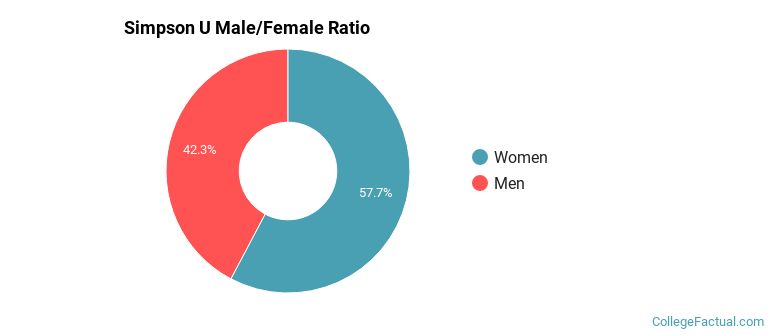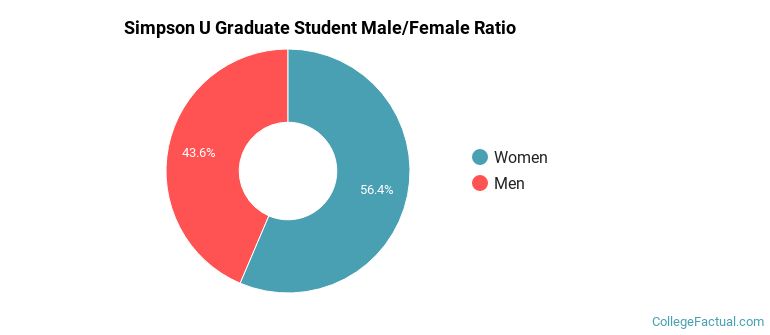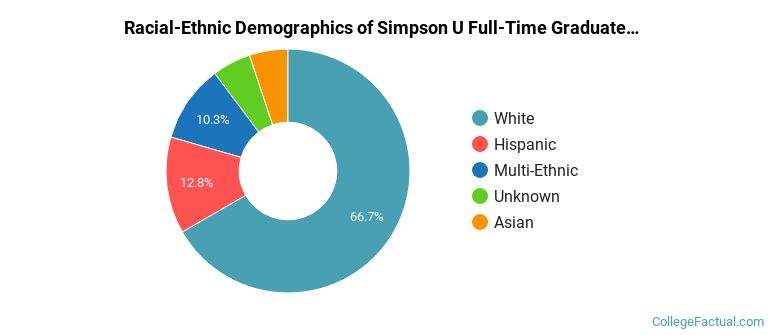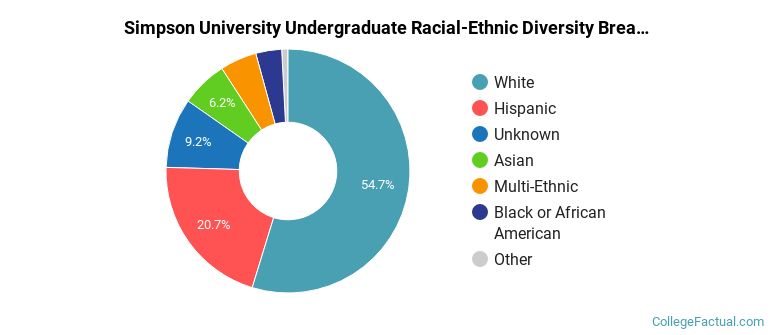 by our College Data Analytics Team
by our College Data Analytics TeamSimpson U total enrollment is approximately 855 students. 549 are undergraduates and 15 are graduate students.
Male/Female Breakdown of Undergraduates
The full-time Simpson U undergraduate population is made up of 58% women, and 42% men.

For the gender breakdown for all students, go here.
Simpson U Racial/Ethnic Breakdown of Undergraduates

| Race/Ethnicity | Number |
|---|---|
| White | 246 |
| Hispanic | 159 |
| Multi-Ethnic | 54 |
| Unknown | 32 |
| Asian | 30 |
| Black or African American | 19 |
| Native Hawaiian or Pacific Islander | 4 |
| International | 0 |
See racial/ethnic breakdown for all students.
Male/Female Breakdown of Graduate Students
About 73% of full-time grad students are women, and 27% men.

For the gender breakdown for all students, go here.
Simpson U Racial-Ethnic Breakdown of Graduate Students

| Race/Ethnicity | Number |
|---|---|
| White | 10 |
| Hispanic | 2 |
| Unknown | 2 |
| Multi-Ethnic | 1 |
| Asian | 0 |
| Black or African American | 0 |
| Native Hawaiian or Pacific Islander | 0 |
| International | 0 |
See racial/ethnic breakdown for all students.

| Race/Ethnicity | Number |
|---|---|
| White | 417 |
| Hispanic | 208 |
| Unknown | 78 |
| Multi-Ethnic | 63 |
| Asian | 40 |
| Black or African American | 32 |
| Native Hawaiian or Pacific Islander | 4 |
| International | 0 |

There are approximately 537 female students and 318 male students at Simpson U.
Simpson U ranks 1,265 out of 2,183 when it comes to geographic diversity.
15.38% of Simpson U students come from out of state, and 0.85% come from out of the country.

The undergraduate student body is split among 11 states (may include Washington D.C.). Click on the map for more detail.

| State | Amount |
|---|---|
| California | 99 |
| Oregon | 5 |
| Washington | 3 |
| Hawaii | 2 |
| Nevada | 2 |
A traditional college student is defined as being between the ages of 18-21. At Simpson U, 40.86% of students fall into that category, compared to the national average of 60%.

| Student Age Group | Amount |
|---|---|
| 20-21 | 190 |
| 35 and over | 190 |
| 18-19 | 179 |
| 22-24 | 140 |
| 25-29 | 119 |
| 30-34 | 75 |
| Under 18 | 0 |
Footnotes
*The racial-ethnic minorities count is calculated by taking the total number of students and subtracting white students, international students, and students whose race/ethnicity was unknown. This number is then divided by the total number of students at the school to obtain the racial-ethnic minorities percentage.
References
Department of Homeland Security Citizenship and Immigration Services
Image Credit: By Morgan Riley under License
Learn more about how College Factual creates their Diversity Rankings.